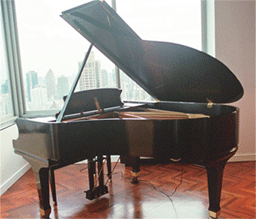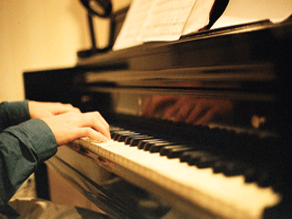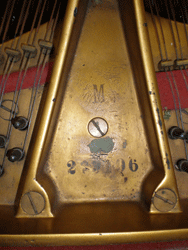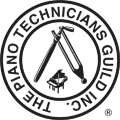Do I own an upright or a grand piano, and what is the difference?
An upright piano stands vertical and a grand stands horizontal. The grand piano is generally more expensive and has a larger sound, while the upright takes up much less floor space. The biggest difference from my point of view is the way "the action" operates. "The action" is the pieces of the piano which you play. The keys are the easiest part to see of the action. The rest is hidden on an upright, and partially hidden on a grand.

Grand Piano

Upright Piano
The action of the two types of pianos rely on the same principle. The action is the part of the piano that moves when you play. A key is pressed and a felt hammer hits a string and then returns. First to explain what I mean by returning. For the hammer to strike the string, a little L shaped piece called a "jack" pushes up under the hammer. The jack forces the hammer into the string and drops back, allowing the hammer to return. The returning enables the hammer to be ready to hit the string again, and is very different on the two types of pianos.
On an upright a spring, gravity, and momentum, assist in returning the hammer. A spring pushes the jack back under the hammer, and a spring helps to push the hammer back to where the jack sits. On a grand, a more complex mechanism acts on the returning of the hammer. The hammer is pushed up by the jack, and once the jack gets out of the way to let the hammer return, a lever moves up and holds the hammer closer to the string, enabling the jack return fully under the hammer ready to strike again. This time, though, the hammer is much closer to the string. Because of this, you can repeat the note very quickly and softly, much more so than on an upright. The dampers are also very different, and the grand dampers tend to be superior. On an upright, the dampers return to the string by a spring, whereas on a grand they return to the string by gravity.
This difference, along with the difficulty in accessing the damper mechanism on an upright to make minute adjustments, make the grand damper much easier for the piano technician to "regulate" or make regular. Making each key on a piano behave the exact same way, with the same movement being required to push down each key from one to the next, is very important in being able to play the piano as well as it can be played. This is because if one key requires a different action (say C needs more force to hit the string than D) then it is much harder to control the volume of the keys you are playing.
Of course there are many other differences between the two types of pianos, and there are exceptions to these differences because of the freedom of innovation piano makers have had in the construction of pianos. They created vast numbers of different shapes and different sizes of pianos, with many different types of actions.

Grand Action

Upright Action
What size is my piano?
The size of the upright is simply the length of the top of the case to the bottom of the floor. Upright pianos are called different things depending on how tall the piano is. This is because the action has to be constructed differently in order to function in each size. The type of action actually dictates what type of piano you have, rather than the size; however, the size is usually indicative of what type of action the piano uses. Spinet pianos are <44", consoles are 45"–48", studios uprights are 45"–48", and full uprights are >51". Besides the action, strings are different in that the larger the piano, the longer the string. This makes a difference, particularly in the bass where a longer string has a much louder sound, and is clearer in defined pitch. On a grand piano, measure from the front of the keyboard to the tail of the piano. People often call small grands "baby grands" although there is no solid definition for what this means. Usually a "baby grand" seems to be smaller than 5'7". On grand pianos the action is not affected by the size of the piano, but the string length is, and again, the longer the string length, the more sound. Particularly in the bass.
How do I clean my piano?
It is probably best to let your piano technician clean the piano, or at least show you how in person. That being said, here are some pointers if you decide you want to do it yourself. Using a feather duster is good pretty much anywhere on the piano. For the keys, a slightly damp rag and light detergent should bring back some shine to plastic keys. If you have ivory keys, use even less water and no detergent, and be very carful. Ivories are sensitive to liquid and too much can cause them to warp. Wipe towards you, in and out rather than side to side. Make sure to use very little water in either case, just enough to wash off the dust and grime without dripping on the piano. Also, don't get any liquid on the strings or the inside of the piano! This is where the piano is very sensitive, and is often where people have problems with their pianos. On the inside of a grand piano, you can vacuum the strings, the part of the soundboard that is accessible, and the tuning pin area, but it is probably better not to do much else. Make sure not to put pressure on the strings, and if you see anything moving, don't vacuum there because this part of the piano should stay still. The case can be cleaned as you would any other finished wood. Pianos generally have either a lacquer or polyester finish.
What kind of piano do I own?
To find out the make of your piano, you usually just have to look at the fallboard. The "fallboard" is the piece of the piano case that closes over the keys. When it is open, the make of the piano is usually displayed just above the center of the keyboard.

Fall Board
The model and serial number of the piano are usually found on the cast iron plate inside of the piano, near where the piano tuner places his hammer to tune the strings. To find the serial and model numbers on a grand, check to see if the front of the lid is turned back and the music desk (the part where you put music on) can be seen. If it is, just look around the tuning pins for letters and numbers. If the front part of the lid is not open, just lift back the front hinged part of the case, exposing the tuning pins. The letters and numbers are usually somewhere near the center of the piano, on the cast iron plate. On an upright, just lift the top hinged part of the case back. This part is usually covered with books and pictures and other things. Then look around for some numbers and letters towards the center, parallel to the tuning pins. The model is useful for the description of the piano, and the serial number is useful in determining the age.

Serial and Model Number
If you have any other questions about pianos or piano-related things, please email me your question.

